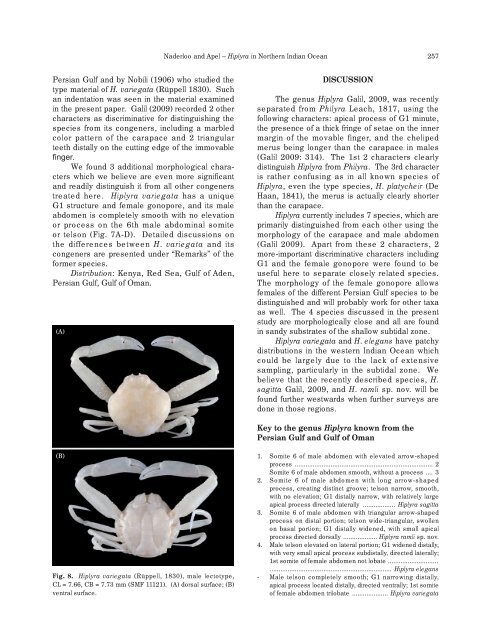Download PDF - Zoological Studies - Academia Sinica
Download PDF - Zoological Studies - Academia Sinica
Download PDF - Zoological Studies - Academia Sinica
Create successful ePaper yourself
Turn your PDF publications into a flip-book with our unique Google optimized e-Paper software.
Naderloo and Apel – Hiplyra in Northern Indian Ocean 257<br />
Persian Gulf and by Nobili (1906) who studied the<br />
type material of H. variegata (Rüppell 1830). Such<br />
an indentation was seen in the material examined<br />
in the present paper. Galil (2009) recorded 2 other<br />
characters as discriminative for distinguishing the<br />
species from its congeners, including a marbled<br />
color pattern of the carapace and 2 triangular<br />
teeth distally on the cutting edge of the immovable<br />
finger.<br />
We found 3 additional morphological characters<br />
which we believe are even more significant<br />
and readily distinguish it from all other congeners<br />
treated here. Hiplyra variegata has a unique<br />
G1 structure and female gonopore, and its male<br />
abdomen is completely smooth with no elevation<br />
or process on the 6th male abdominal somite<br />
or telson (Fig. 7A-D). Detailed discussions on<br />
the differences between H. variegata and its<br />
congeners are presented under “Remarks” of the<br />
former species.<br />
Distribution: Kenya, Red Sea, Gulf of Aden,<br />
Persian Gulf, Gulf of Oman.<br />
(A)<br />
DISCUSSION<br />
The genus Hiplyra Galil, 2009, was recently<br />
separated from Philyra Leach, 1817, using the<br />
following characters: apical process of G1 minute,<br />
the presence of a thick fringe of setae on the inner<br />
margin of the movable finger, and the cheliped<br />
merus being longer than the carapace in males<br />
(Galil 2009: 314). The 1st 2 characters clearly<br />
distinguish Hiplyra from Philyra. The 3rd character<br />
is rather confusing as in all known species of<br />
Hiplyra, even the type species, H. platycheir (De<br />
Haan, 1841), the merus is actually clearly shorter<br />
than the carapace.<br />
Hiplyra currently includes 7 species, which are<br />
primarily distinguished from each other using the<br />
morphology of the carapace and male abdomen<br />
(Galil 2009). Apart from these 2 characters, 2<br />
more-important discriminative characters including<br />
G1 and the female gonopore were found to be<br />
useful here to separate closely related species.<br />
The morphology of the female gonopore allows<br />
females of the different Persian Gulf species to be<br />
distinguished and will probably work for other taxa<br />
as well. The 4 species discussed in the present<br />
study are morphologically close and all are found<br />
in sandy substrates of the shallow subtidal zone.<br />
Hiplyra variegata and H. elegans have patchy<br />
distributions in the western Indian Ocean which<br />
could be largely due to the lack of extensive<br />
sampling, particularly in the subtidal zone. We<br />
believe that the recently described species, H.<br />
sagitta Galil, 2009, and H. ramli sp. nov. will be<br />
found further westwards when further surveys are<br />
done in those regions.<br />
Key to the genus Hiplyra known from the<br />
Persian Gulf and Gulf of Oman<br />
(B)<br />
Fig. 8. Hiplyra variegata (Rüppell, 1830), male lectotype,<br />
CL = 7.66, CB = 7.73 mm (SMF 11121). (A) dorsal surface; (B)<br />
ventral surface.<br />
1. Somite 6 of male abdomen with elevated arrow-shaped<br />
process ............................................................................. 2<br />
Somite 6 of male abdomen smooth, without a process .... 3<br />
2. Somite 6 of male abdomen with long arrow-shaped<br />
process, creating distinct groove; telson narrow, smooth,<br />
with no elevation; G1 distally narrow, with relatively large<br />
apical process directed laterally .................. Hiplyra sagitta<br />
3. Somite 6 of male abdomen with triangular arrow-shaped<br />
process on distal portion; telson wide-triangular, swollen<br />
on basal portion; G1 distally widened, with small apical<br />
process directed dorsally ................... Hiplyra ramli sp. nov.<br />
4. Male telson elevated on lateral portion; G1 widened distally,<br />
with very small apical process subdistally, directed laterally;<br />
1st somite of female abdomen not lobate ............................<br />
.................................................................... Hiplyra elegans<br />
- Male telson completely smooth; G1 narrowing distally,<br />
apical process located distally, directed ventrally; 1st somite<br />
of female abdomen trilobate .................... Hiplyra variegata

















